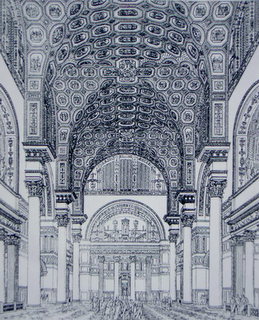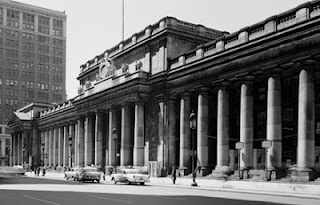 Rome the Second Time is proud to present its 400th post. We are grateful to our readers for their appreciation of our content and tolerance of our eccentricities.
Rome the Second Time is proud to present its 400th post. We are grateful to our readers for their appreciation of our content and tolerance of our eccentricities.
There is only one monument in Rome to McKim, Mead and White, the New York City-based firm that dominated American architecture in the half century after 1880--some 1,000 commissions, dozens of reknowned buildings. It is the building housing the American Academy in Rome, still there and still operating more than one hundred years after its completion in 1913/14. It is a gracious structure, superb in its balance and proportion, restrained in its ornamentation, representing the genteel tradition in architecture as fully as Henry James did for the novel. [As an update, we note an exhibition on the design and construction of the AAR building - a merely okay not a must-see exhibition - is at the Academy, open 4 to 7 p.m. Fridays, Saturdays and Sundays through June 29, 2014.]
 |
McKim's NYS pavilion, 1893,
modeling the Villa Medici |
Indeed, the firm's link to the American Academy goes beyond the structure. Although most of his knowledge of continental architecture was from books, and he did not see Rome until 1885, Charles Follen McKim was enamoured of European architecture. Though he favored Italian over French design, McKim valued the French system of architectural training, and he would have been pleased to have studied Rome's architectural heritage at the French Academy, housed in the the Villa Medici--had he been a citizen. Convinced that travel to Europe and physical immersion in its architectural splendors was essential to becoming an architect, McKim joined with another distinguished architect in the genteel tradition, Daniel Burnham, to found a post-graduate facility for architects in Rome--what became the American Academy. The two solicited contributions from friends and fellow architects and brought the first class to Rome in 1895, where they were housed in temporary quarters. The first painters and sculptors arrived in 1897.
 |
| Stanford White's Washington Square arch |
Rome was influential in some of the firm's most important works. The Washington Memorial Arch, the signature of Washington Square, was designed by the flamboyant Stanford White, who based its shape on encyclopedic knowledge of the precise dimensions of dozens of Roman and Roman imperial arches. McKim based his design for the New York State pavilion at the 1893 Chicago World's Fair (above left) on the Villa Medici, and, according to one architectural historian, used his knowledge of the upper stage of the nymphaeum of the Villa Giulia (mid-16th century) to compose the facade of the Morgan Library in New York City. Facade inscriptions on McKim's University Club in New York City, though critically received by its members, were incorporated into the final design when McKim explained that inscriptions were common to a variety of Rome structures, including Palazzo Spada, Porta Maggiore and Porta del Popolo, and the Acqua Paola fountain.
To catch a glimpse of the most famous McKim, Mead and White building inspired by Rome, you'll have to go to New Jersey and dig around in its swamps and marshes. "Tossed into the Secaucus graveyard," wrote Ada Louise Huxtable, architectural critic of the
New York Times, "are about 25 centuries of classical culture and the standards of style, elegance and grandeur that it gave to the dreams and constructions of Western man." She was referring to the Pennsylvania Station, arguably the most glorious and surely the most famous of the many structures designed by the firm, torn down between 1963 and 1965 (to make way for a skyscraper and a new Madison Square Garden), in what Lewis Mumford called "an irresponsible act of public vandalism."

Construction of the Pennsylvania Station began in 1904 and was completed in 1910, in the midst of the presidency of William Howard Taft. The design was McKim's, as was the decision to exclude a high-rise hotel desired by the railroad--a decision, according to historian Leland M. Roth, that doomed the building to its Secaucus fate. It was enormous in every sense: 430 X 780 feet, two whole city blocks, sitting on 650 steel columns and, because of the unusual terrain, the trains were out of the way, 45 feet below street level.
 |
| Pennsylvania Station waiting room |
It is well known that McKim's design--apparently worked out with Alexander Cassatt, brother of the painter, Mary Cassatt--was profoundly influenced by the monumentality and grandeur of the Baths of Caracalla (212-216 AD). McKim had hired people to amble through the Baths so he could get a sense of scale and of human movement through its large spaces.
.png) |
| A reconstruction of the Baths of Caracalla |
Though the Station was bigger than the Baths--the general waiting room was some 20% larger--it was proportional to the ancient structure, and the waiting room of the Station was modeled on the Baths' tepidarium, or warm room (right and end of post). Unlike the Baths, the vaults of McKim's Station were not structural; they only defined the space. The Corinthian columns were sheathed in travertine from near Tivoli.
 |
| Pennsylvania Station concourse |
The Concourse--where travelers descended to the trains--was an airy delight, "one of the marvels of early twentieth-century engineering," according to Roth, and reminiscent of Giovanni Battista Piranesi's 18th-century etchings of imaginary prisons, according to architectural critic Martin Filler. Outside, McKim's colonnade took inspiration from the Bank of England and Bernini's Piazza di San Pietro.
 |
| Pennsylvania Station, colonnade |
The Pennsylvania Station was much admired for many years, and its neo-classical monumentality remained a popular form on Washington's mall and in the late-1930s suburb of EUR, where Mussolini's Fascist regime adapted the style to modernism. As the years went by, and enthusiasm for modernism--and modernist forms of the monumental, like the Empire State Building, or the glass box housing the United Nations--grew, the Station fell out of favor. It was allowed to accumulate an unsightly layer of dirt and grime, and by the early 1960s, before there was much interest in conserving important old buildings, its defenders were too few to make a difference. Frank Lloyd Wright's massive Larkin Administration Building in Buffalo came to a similar end in 1950. And today, to experience what McKim had in mind, you'll have to buy a ticket to the Baths of Caracalla, or head for the wetlands of New Jersey, trowel in hand.
Bill
 |
| Design for a proposed reconstruction of the Tepidarium, Baths of Caracalla, 1889 |



.png)





No comments:
Post a Comment